Auke Visser's International Esso Tankers site | home
TORPEDOED, MINED, BEACHED
MS "J. A. Mowinckel".
The Panama Transport Company tanker J. A. Mowinckel was the second of three ships torpedoed in quick succession du-ring a Uboat attack on a convoy off Cape Hatteras, July 15, 1942. Under naval escort the crippled tanker headed for shore, but inadvertently entered a U. S. mine field, the existence of which was not known to her master. After further damage, by either another torpedo or a mine, the ship was abandoned.
The J. A. Mowinckel remained afloat and salvage operations were begun. One of the tugs assisting in the work hit a mine and sank. The tanker was successfully beached in Hatteras Inlet, was refloated, and shortly thereafter struck another mine. Finally she was towed to Hampton Roads, Virginia, then to Baltimore, where temporary repairs were made. Permanent re-pairs werecompleted in dry dock at New York.
The J. A. Mowinckel had a merchant crew of 46 officers and men and a U. S. Navy armed guard of 13. A number of men we-re badly injured by the torpedo explosion; one crew member and one member of the armed guard died from their wounds.
The MS J. A. Mowinckel was built in 1930 by Cantiere Navale Triestino, at Monfalcone, Italy. She is a sistership of the Peter
Hurll, the J. H. Senior, and the F. H. Bedford, Jr. The Heinricli v. Riedemann, torpedoed and sunk on April 16, 1942, was also a sistership.
A twin-screw vessel of 17,755 deadweight tons capacity on international summer draft of 30 feet, 8 inches, she has an over-all length of 540 feet, a length between perpendiculars of 520 feet, a moulded breadth of 70 feet, and a depth moulded of 38 feet, 9 inches. With a cargo carrying capacity of 139,765 barrels, she has an assigned pumping rate of 4,000 barrels an hour.
Her Diesel engines developed 5,000 brake horsepower and give her a classification certified speed of 12.1 knots.
In August of 1939, while war clouds were gathering over Europe, the /. A. Mowinckel was on her way around South America.
Having discharged at Buenos Aires and Campana, Argentina, she proceeded, via the Strait of Magellan, to Talara and then to
Balboa, Canal Zone, where she arrived on the first day of war, September 3, 1939. At Balboa, on September 16, her German crew was replaced by Americans sent from New York. Captain Frank I. Shaw became master of the vessel and Chief Engin-eer Max J. Voss look charge of her engineroom.
The J. A. Mowinckel left the Canal Zone September 18 and arrived at Cartagena September 19 to load her first wartime cargo, 116,877 barrels of Colombian crude for Aruba. From that time until she was damaged off Hatteras, the J. A. Mowinck-el remained in western Atlantic service. Loading in the Caribbean, she discharged her cargoes alternately at New York and Brazilian ports.
The vessel was time chartered to the United States War Shipping Administration on May 29, 1942.
Rescued Four from Raft in 19 Minutes.
On June II, 1942, a month and four days before her own misadventure, the /. A. Mowinckel picked up four survivors of a tor-pedoed ship and thereby played a role in one of the strange sea dramas of World War II. Captain Harold Griffiths, in reporting
the incident from Aruba, N. W. I., oh June 16, 1942, said: "At 9 p.m., June II, in Latitude 18?29' North, Longitude 85?54' West,
we picked up from a life raft four survivors of the Netherlands steamer Crijnssen, which was torpedoed at 6:35 p. m., June 10, 100 miles west of Swan Island (in the western Caribbean).
"The four survivors were Captain William van der Giessen, Second Mate Willem Heimensen, and Stewards Alexander Schneider and Jacob J. van Hoepen. \Ve proceeded to Aruba with them, arriving June 16.
"I would like to lay special emphasis on the quick dispatch of our lifeboat, equipped with an outboard motor. The raft was
helpless and on account of the sea running we could not get alongside and did not want to remain in that vicinity very long.
Rowing would have taken much more time.
"As soon as we had reduced speed safely enough for lifeboat launching, we lowered the boat, started the motor, reached the raft, took off the survivors, returned to the J. A. Mowinckel, and hoisted the boat with the ship's winches, all in 19 minutes."
The SS Crijnssen, a passenger ship of 4,298 gross tons, owned by the Royal Netherlands Steamship Company, was bound from Curacao to New Orleans when she was attacked at Latitude 18? 14' North, Longitude 85?11' West, or about 150 miles off the coast of Yucatan, Mexico. Among her passengers were 15 survivors of three previously torpedoed vessels, and in-cluded in this group was Roy A. Peacock, officers' messman from the Esso tanker T. C. McCobb, lost March 31, 1942. Also aboard were several refugees from occupied Europe who found, tragically, that even in the waters of the New World they were not safe from the long arm of their late oppressors.
Thirty-one survivors of the Crijnssen were picked up by the Socony-Vacuum Oil Company, Inc., tanker Sylvan Arrow and landed at Xcalak, Yucatan. Eighteen others reached land in lifeboats.
A number of other passengers and crew members of the Crijnssen, among them Roy A. Peacock, were rescued by a se-cond ship, which was later torpedoed. Set adrift a second time, this unfortunate group reached land in a lifeboat and even-tually arrived at the Canal Zone. Peacock's adventures are told in detail in the chapter on the T. C. McCobb.
Captain van der Giessen and the three men with him were the last to leave the Crijnssen. They had inspected the sinking vessel to make certain that no one was left aboard and had abandoned her, climbing on a life raft when the fore part of the ship was under water and it was certain that she would sink.
The J. A. Mowinckel left New York for Aruba on July 9, 1942. She carried no oil in bulk but had on board a quantity of dry car-go, much of which consisted of refrigerated perishable provisions, and 6,000 tons of drinking water.
The dry cargo and water were intended for Aruba.
The 19 vessels of convoy KS 520 gathered from many east coast ports to assemble in Chesapeake Bay July 12 and 13. The J. A. Mowinckel became the commodore ship when, on July 12, Captain Newton L. Nichols, USN, convoy commodore, came aboard, accompanied by three Navy signalmen.
"Our ship," Chief Mate John Reckstin, of the J. A. Mowinckel, reported, "was armed with a 4-inch gun aft and two 50-caliber
machine guns, one on each side of the after boat deck. The crew, including Captain Harold Griffiths, totaled 46 men, the armed guard, 13. KS 520 was heavily protected. The surface escort consisted of two destroyers, the USS Ellis (DD 154) and the USS McCormick (DD 223) ; two Navy patrol craft, one of which was the USS Spry, a Canadian-built corvette; and a Coast Guard cutter. On guard in the air were a Navy blimp and several patrol bombers. The convoy formed up and left Lynn-haven Roads, at the entrance to Chesapeake Bay, southbound, on July 14.
The Convoy Attack.
The attack, in which there appear to have been several submarines involved, came on the afternoon of July 15, 1942, when KS 520 had reached a point about 33 miles south by east of Cape Hatteras - Latitude 34?44' North, Longitude 75? 19' West. On the bridge of the J. A. Mowinckel at the time were her master, Captain Griffiths; the convoy commodore, Captain Nichols; Chief Mate Reckstin; Second Mate Charles M. Lutburrow; and, at the wheel. Able Seaman Sven E. Roos. Able Seaman Henry G. Phillips was lookout on the foc'sle head. The three Navy signalmen were standing on top of the wheelhouse and the gun crew were at their stations. The weather was clear, with a light breeze and moderate sea. The speed of the convoy was 8 knots.
Master's Account.
Captain Griffiths gave a detailed account of the action and of subsequent events:
"No one aboard my ship observed a submarine before the attack, but four torpedoes were launched almost simultaneously at 4:25 p.m. The first victim was the SS Chilore (approximately 22,000 deadweight tons, owned by the Ore Steamship Company), which was to port of us in the convoy. She was struck on her port bow. A few seconds later the J. A. Mowinkel caught the second torpedo, in her stern. The third hit the SS Bluefields (2,063 gross tons, owned by A. Garcia and Co., Ltd., of Bluefields, Nicaragua) on the port side amidships. The fourth torpedo passed astern of the J. A. Mowinckel.
"The Bluefields sank in four minutes. The J. A. Mowinckel and the Chilore were crippled by the torpedoes, but did not sink.
"Immediately following the explosion of the torpedo which struck the Chilore, a submarine partly surfaced, bow first. Possibly
she was forced upward by the concussion. Observers on the Chilore later told me that they plainly saw the U-boat and iden-tified her as 'No. 76'.
"The submarine's appearance was the signal for our escort to go into action. Planes dived over the spot. Our airplane escort
continued to drop bombs or depth charges. The two escorting destroyers also raced to the scene and dropped depth charg-es.
Finally wreckage and considerable oil sludge and slick were seen to rise to the surface. This evidence, combined willi my
observation of the speed and efficiency with which the escort went into action and the patterns in which the depth charges were dropped, leaves absolutely no doubt in my mind but that the submarine was destroyed."
Sub Identified and Sunk.
(With reference to this statement of Captain Griffiths and to the "identification" of the U-boat by observers on the Chilore as "No. 76", it is of interest to note that Navy Department records, checked since the end of the war from German sources, pro-ve that the Nazi submarine U 576, while attacking convoy K.S 520, was destroyed on July 15, 1942, in Latitude 34?51' North, Longitude
75?22' West. Credit for the kill was given to the Navy plane VS-9 and to a ship in the convoy, the SS Unicoi, owned by the War Shipping Administration.) Chief Mate Reckstin said:
"When the J. A. Mowinckel was struck. Captain Griffiths ordered me to sound the general alarm and telegraph the engine-room to stop the engines. The ship was listing slightly to starboard and swinging off her course.
"The crew took to their respective stations in good order and started to lower the forward boats down to the main deck, and then awaited further orders. Captain Griffiths instructed Radio Operator Maurice W. Peters to send out a distress message, but the SOS was stopped shortly afterward by the convoy commodore, Captain Nichols, as the necessary action was being taken by the escorting vessels."
Tanker Damage.
To resume the quotation of Captain Griffiths' statement: "A survey of the damage ascertained that we had been hit about 8 feet below the waterline and right aft, the explosion tearing a 20 by 20 foot hole in the plates and blowing through the after peak and the steering engine room. The steering engine and capstans, the galley, the messrooms, and the after gun plat-form were wrecked.
"There was a 6-inch hole in the after bulkhead in the engineroom. All of the rivets were leaking badly and the engineroom be-gan filling up. Chief Engineer Cecil M. Guthrie ordered his men to stuff a mattress in the hole and brace it there with planks, but the water kept coming in with considerable force. The chief engineer had to put all his pumps on the bilge to try to keep the water down.
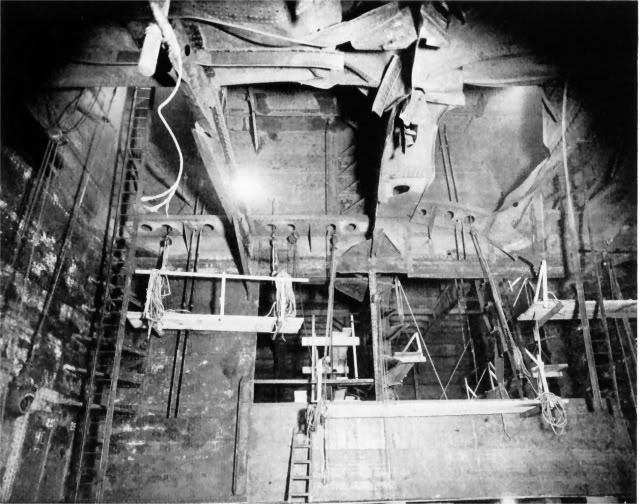 Repairing cargo-hold of the "J.A. Mowinckel".
"He found, however, that both engines were operable and I therefore decided to make for shore in the hope of saving my ship. As the steering engine was useless it would be necessary to steer with the twin screws. I ordered Chief Mate Reckstin to drop a mooring line over the starboard quarter to assist with the steering. He also attempted to trim the ship by shifting wa-ter from No. 6 starboard to No. 3 port tank.
"By this time the J. A. Mowinckel and the Chilore had dropped astern of the convoy. The master of the Chilore had also deci-ded to head for shore. Captain Nichols reported our intention to the escort destroyer Ellis, which assigned the corvette Spry to accompany us to Ocracoke Inlet.
"The explosion of the torpedo had seriously injured several crew members of the J. A. Mowinckel and five of the U. S. Navy
gunners. At my request, Captain Nichols signaled to the escort tor medical aid. About 20 minutes later the McCormick put
Lieutenant Larkin, Medical Corps, USN, aboard to attend to the wounded."
Caring for the Injured Steward Nemuel J. Camp, who assisted Lieutenant Larkin in caring for the injured men, told the follo-wing story in an interview for this history:
"At 4:25 p.m., I was on the port side of the ship, aft-outside the galley. Seeing smoke from the Chilore, I ran up to the boat deck. I had just arrived there when we were struck. The concussion knocked me down. As I got to my feet, I felt the ship sha-king from the explosion. Water was thrown up through the hole in the gun platform.
"Second Assistant Engineer Lawrence 0. Nolan shouted for someone to help with the wounded and assist in bringing Crew
Messman Edward Krutz to the boat deck. (Krutz was one of the more seriously injured men. He had been working in the crew's messroom at the time of the explosion and was found lying on the starboard side of the after deck, opposite the messroom door.) Electrician Paul E. Wilson went down to assist. I saw Storekeeper Clemente Colmenero lying on the alter deck and helped to carry him up. The two wounded men were laid on the starboard side of the boat deck.
"From the galley I brought hot water, towels, and three folding cots. We put Krutz, Colmenero, and one of the gunners on the
cols. Third Mate Ernest Johnson gave them first aid. I went forward and reported to Captain Griffiths the condition of the
wounded men. He told me that the escort had been requested to put a doctor aboard. I returned aft.
"When Lieutenant Larkin arrived, he sent me for some drugs, which Captain Griffiths got from the safe.
The doctor treated the injured men with great care, but was unable to save Storekeeper Colmenero. He died while receiving a plasma transfusion."
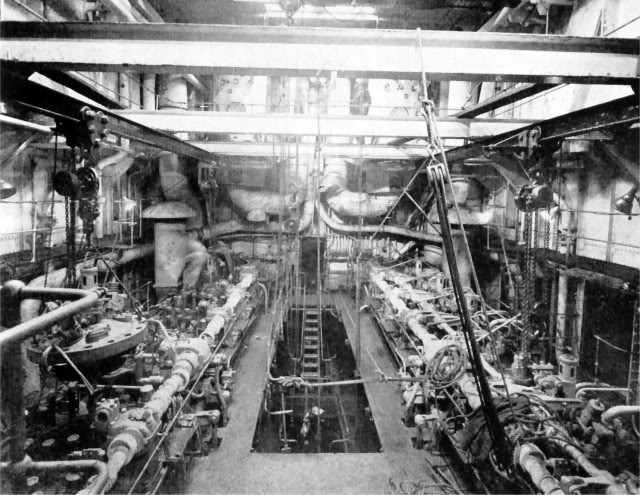 At repair-yard, "Mowinckel's" engineroom , showing cilinder head level, looking forward.
Electrician Wilson reported:
"At the time of the attack I was with Chief Engineer Guthrie in his room. We proceeded to the scene of the damage on the after deck,, where I saw Krutz lying in the scuppers opposite the messroom door. All the furniture in the messroom was smashed to pieces and the floor was shattered. Mr. Nolan and I carried Krutz to the boat deck. He had a long cut down the side of his face and was bleeding from his mouth. He was unconscious. I went down again and helped bring up Storekeeper Colmenero and three of the injured gunners."
Ordinary Seaman (later Third Mate) Jerome Wheelock said:
"I was taking a shower when we were first hit. Debris shot up fanwise clean through the gun platform. The Navy gunner who
afterward died was on watch there at the time of the attack."
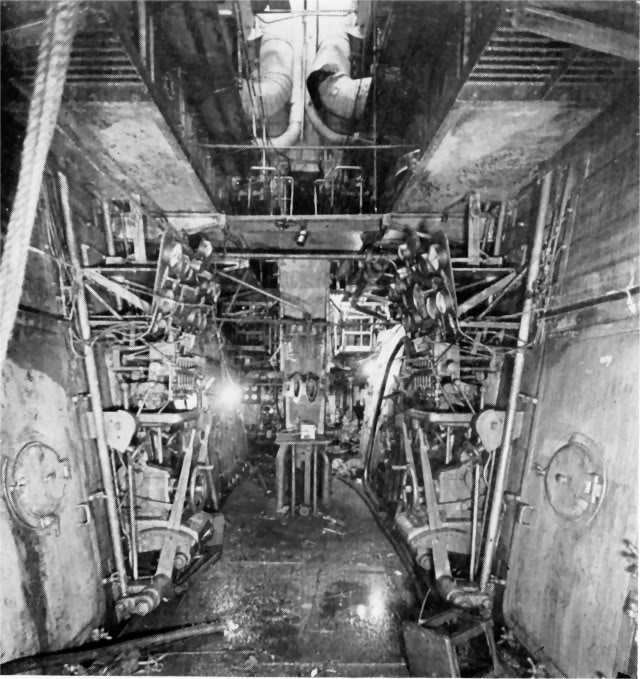 Operating platform, looking forward between two main motorsbefore repairing torpedo and flood damage.
In Mine Field.
Soon after being torpedoed, the /. A. Mowinckel started toward shore at a speed of about 5 knots, accompanied by the Chilo-re and escorted by the Spry. The port propeller struck against the wreckage, but it was used anyway, as both engines were required to steer. Chief Mate Reckstin rigged an auxiliary steering gear aft. It was hoped that the vessel could reach either Hatteras Inlet or Ocracoke Inlet.
Unknown either to the masters of the J. A. Mowinckel and the Chilore, or, apparently, to the Navy escort, a U. S. mine field lay
between the crippled ships and the shore. They entered it.
To return again to Captain Griffiths' narrative:
"Every effort was made to stop the leaks as we headed for the beach, running on a course of about 315?.
"We had covered about 20 miles and were approximately 13 miles off Ocracoke Inlet when, at 7:55 p.m., there occurred a second explosion, on the starboard side in way of No. 2 tank. Either we had been struck by another torpedo or we had hit a mine.
"Immediately the Spry opened fire on some target and later dropped a number of depth charges. The Chilore began firing at the same spot. Suddenly those aboard the J. A. Mowinckel observed an underwater explosion at a point about 15 degrees off our starboard bow and 1,500 yards distant; a great deal of oil sludge appeared on the surface. Lieutenant Larkin, the Navy doctor aboard the J. A. Mowinckel, mentioned that at the time of the explosion he had seen the conning tower of a subma-rine.
Anchored and Abandoned "It was getting dark. We had a number of wounded men aboard, all injured by the first explosion, and I was afraid that we might again be attacked. After consultation with Captain Nichols, I decided to abandon the vessel. The J. A. Mowinckel was anchored to prevent drift and in the hope that she might later be salvaged.
"At 8:05 p.m. I gave the order to abandon ship. All the injured men were placed in the boats and as comfortably cared for as
possible. I put all the secret documents and codes in a special sealed container and threw them overboard. All tour lifeboats were safely launched."
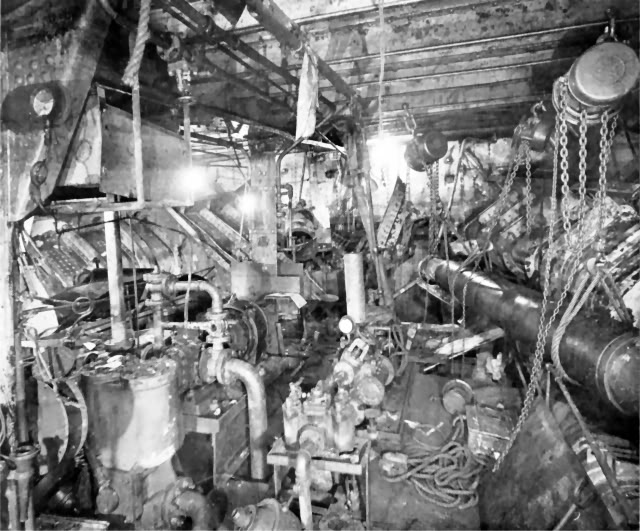 Damage repairs under way. The tanker's lower engineroom, looking aft.
In the meantime, the Chilore, which liad also been damaged in the mine field, was abandoned, so that there was a conside-rable flotilla of lifeboats on this area of sea.
During the night No. 4 boat was found and taken in tow by a Coast Guard patrol craft. At 1 a.m., July 16, the same vessel
encountered lifeboat No. 2, which was heading for Morehead City. Both boats were i^owed to Ocracoke Inlet, where they ar-rived at 4:30 a.m. Lifeboats Nos. 1 and 3 had landed there about an hour and a half earlier.
"I must say," Captain Griffiths reported, "that at all times during the attack, while abandoning ship, and in the boats, the beha-vior, cooperation, and morale of every man was excellent."
At Ocracoke Captain Griffiths learned for the first time that his ship was in a mine field.
The men from the /. A. Mowinckel were all cared for at the Coast Guard Station. Later in the morning several of the seriously
injured crew members and Navy gunners were evacuated by plane. Raymond V. Wolfe, Seaman Second Class, of the U. S. Navy gun crew, subsequently died of his wounds at the Marine Hospital, Norfolk, Virginia, on July 21, 1942, bringing to two the fatalities caused by the attack on the 7. A. Mowinckel. Four survivors of the gun crew were injured.
Ten of the surviving crew members of the J. A. Mowinckel were injured by the explosion:
First Assistant Engineer Harry K. Stringer, Junior Engineer Carl Jensen, Pumpman Almars Krastins, Able Seaman Walter A.
Aubrey, "Ordinary Seaman Max Dynega, Fireman-Watertender Daniel N. Malone, Second Cook Austin W. Cooper, Petty
Officers' Mess-man Carmon A. Kelley, Crew Messman Edward Krutz, and Wiper Joseph J. Sokolowski.
Blown Overboard-Saved.
Wiper Sokolowski's story is of special interest: "When the first torpedo struck the J. A. Mowinckel I was wounded in the left
shoulder by flying metal fragments and was blown overboard. I swam for about twenty minutes without a life jacket; then a crew member of a passing tanker spotted me and tossed down a life preserver.
About an hour later I was sighted from the destroyer USS McCormick. Her crew threw me a line, pulled me aboard, and
administered first aid. Afterward the McCormick came alongside the J. A. Mowinckel. Most of my shipmates thought I was lost.
They were amazed at my sudden appearance aboard another vessel."
On July 16 Sokolowski saw the McCormick attack another submarine; about 27 depth charges were dropped and soon an oil slick appeared on the surface. After six days Sokolowski was put ashore at Key West, on July 21. Questioned by Navy Intelligence, he was released when vouched for by a Company representative, who furnished him with clothing and, on July 22, sent him to New York, where he arrived July 25.
At 1 p.m., July 16, Captain Griffiths, accompanied by his three mates and Chief Engineer Guthrie, together with the first and
second assistants and two third assistant engineers, and the radio operator, returned to the J. A. Mowinckel in Coast Guard
launches, with the intention of determining whether the vessel could be salvaged. With them went ten other members of the crew and several Navy officers. All the crew members were volunteers, as there was considerable danger from mines. The men in one of the launches had a bad moment when the craft scraped against a submerged object, but no mishap resulted.
The 7. A. Mowinckel had settled by the stern and listed to starboard so that part of her after deck was under water. The ship was examined throughout. Soundings were taken in the pumproom and all valves, ullage plugs, and watertight doors were closed. At 8:30 p.m. the survey party arrived back at Ocracoke. Lieutenant Commander Robert E. Permut, USN, one of the Navy officers who had gone aboard the tanker, ordered salvage tugs dispatched to the scene.
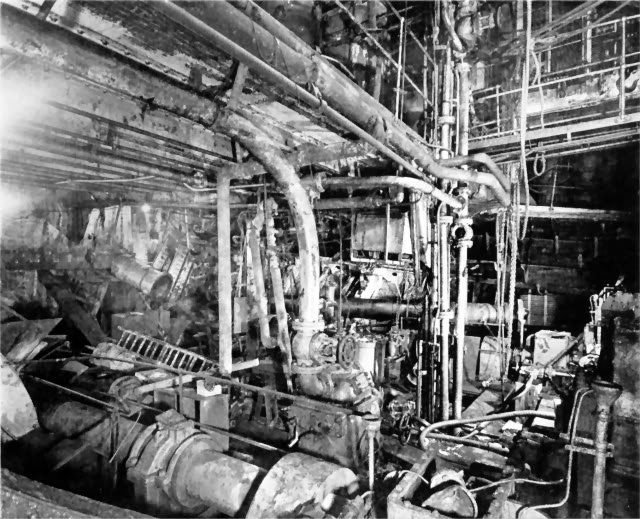 Another view of the "J. A. Mowinckel's" lower engineroom (aft end) looking from starboard to port, showing starboard main
thrust bearing and shaft in foreground.
Salvage.
The Merritt-Chapman Sc Scott Corporation salvage tug Relief arrived on July 17. Captain Griffiths, Chief Engineer Guthrie, and Second Mate Lufbur-row, accompanied by Lt. Comdr. Permut, and Salvage Officer H. 0. Antonsen, revisited the J. A. Mowinckel aboard the Relief and made additional preparations for salvage. Several Navy minesweepers and tugs swept the vicinity for mines.
On July 19 the J. A. Mowinckel's port anchor chain was burned off and at 3:15 p.m. the vessel got under way, under tow of the tug J. P. Martin. The tug Keshena (owned by the Southern Transportation Co., Philadelphia) had a line on the stern and was acting as rudder. At 3:25 p.m., the Keshena struck a mine. She sank in 12 minutes.
How It Was Done.
The J. A. Mowinckel was towed to Hatteras Inlet without further mishap. She reached there at 3 a.m. July 20 and was beach-ed. On July 19, Mr. Guy L. Bennett, then the Company's Port Engineer, now Assistant Manager of the Port of New York Offi-ce, had arrived at Ocracoke. His report is quoted for an account of subsequent operations:
"On the morning of July 20 I proceeded to the vessel, which had been removed from the mine field and placed aground in
Hatteras Inlet. An examination revealed considerable water in her pumproom, and steam from the tug Relief was used to operate a stripper pump to empty the pumproom. As the deck controls of the stripper pump were broken. Second Mate Luf-burrow dived down and set the valves. The ship's cargo pumps, also supplied with steam from the Relief, were used to pump out the after tanks and thus bring the stern up. Then two large, portable, gasoline-driven air compressors were trans-ferred from the Relief to the J. A. Mowinckel.
"The compressors were also connected to the cargo pumps, to be used in case of an emergency when the vessel was being towed, as planned, to a repair yard.
Ice Cream and Frozen Strawberries.
"During these operations the officers of the J. A. Mowinckel and I lived aboard the tanker. For food we had to depend on the
perishable stores which had been consigned to Aruba. As the galley was under water, we had no cooking facilities. For a while we lived on ice cream and frozen strawberries—two items of diet for which I have never since had any desire.
"By the evening of July 21 the /. A. Mowinckel was well afloat. At about 3 a.m. July 22 a detonation was heard and felt. At first it was feared that the ship's ammunition stores had exploded. However, at dawn, an inspection revealed that the J. A. Mo-winckel had dragged her anchor during the night and, apparently, had struck a mine. No. 7 starboard main tank had been damaged and had filled with water, lowering the draft by the stern about 4 feet. We immediately began pumping and blowing water out of both sides of No. 7 starboard main tank to bring the vessel up by the stern. These and other salvage operations continued throughout the daylight hours of July 22. In the meantime the ship was made ready for tugs which were to arrive on July 23."
On July 23 the Relief towed the /. A. Mowinckel out and met the Navy ocean-going tug USS Sciota and two Canadian escort
vessels, the corvettes HMCS Norwood City and HMCS Hertfordshire. Mr. Bennett then returned ashore.
Under tow by the two tugs and guarded by the corvettes, the J. A. Mowinckel proceeded to Hampton Roads, Va., in Chesa-peake
Bay, arriving July 25. Here the dry cargo was removed. The tanker left Hampton Roads, in tow, on August 1 and arrived Au-gust 3 at Baltimore, where temporary repairs were made. She was towed from Baltimore September 6 and reached New York September 10. Permanent repairs were begun September 15, 1942 and completed March 12, 1943.
While the operation of salvaging the /. A. Mowinckel was going forward, a similar effort was being made to save the Chilore.
After being crippled by a torpedo in the first attack, this vessel had struck several mines. She was later taken in tow, the in-tention being to bring her to Norfolk. The Chilore liad reached the entrance to Chesapeake Bay when she capsized apd sank on July 24, 1942.
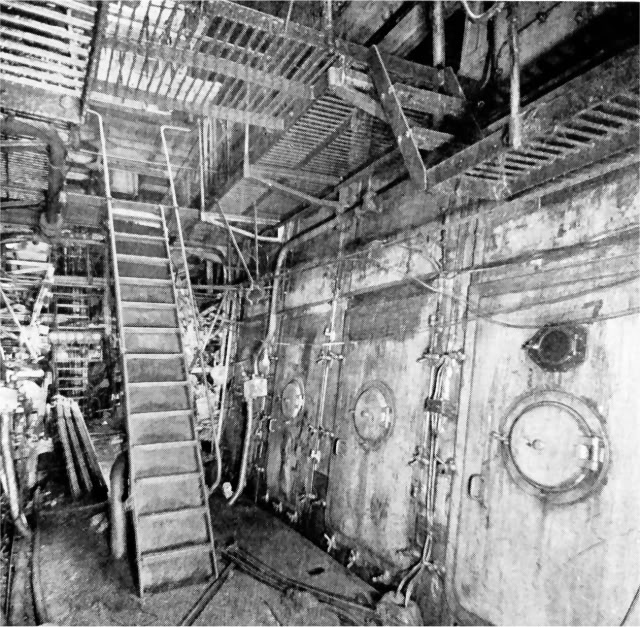 Some of the disruption in the section of the "J. A. Mowinckel's" lower engineroom, between the main motors, looking aft.
Captain Harold Griffiths was first employed by the Company as an able seaman on March 31, 1922. On June 16, 1926 he became a third mate and was promoted to master on April 20, 1934. He is a lieutenant commander in the U. S. Naval Reser-ve.
Chief Engineer Cecil M. Guthrie first came with the Company August 4, 1934 as oiler. He became third assistant engineer April 24, 1936 and received his promotion to chief engineer March 2, 1940. Since January 6, 1944, he has been a repair in-spector at the Port of New York.
Eight crew members of the J. A. Mowinckel, as of July 15, 1942, were on other Company tankers sunk or damaged by ene-my action:
Third Assistant Engineer Hugh C. Oliver and Fireman, Watertender Francis D. O'Brien later lost their lives on the C.J. Bark-dull, in December, 1942. Steward Nemuel J. Camp and Able Seaman Sven E. Roos had been on the Esso Bolivar when she was shelled and torpedoed, March 8, 1942. Able Seamen Joseph A. Arnold and Walter A., Aubrey had survived the sinking of the Heinrich v. Riedemann, April 16, 1942; and Able Seaman Henry G. Phillips was a survivor of the I. C. White, lost on Sep-tember 27, 1941.
Wiper Joseph J. Sokolowski had been a crew member of the Esso Bolivar on March 8, 1942 and he later survived the sin-king of the H. H. Rogers, February 21, 1943.
The transportation record of the J. A. Mowinckel during the war years was in summary as follows:
The wartime masters of the J. A. Mowinckel were Captains Frank I. Shaw, Charles J. Stadelman, Lionel E. Crowder, James S. LeCain, Ernest C. Kelson, Harold Griffiths, Alfred J. Thorson, Herbert A. Nelson, Aage Petersen, Alexander J. Zafiros, and
Daniel H. Larsen.
During the same period her engineroom was in charge of Chief Engineers Max J. Voss, Andrew R. Jackson, Harry L. Hoyland, James F. Maher, Charles E. Clark, John F. Cordes, Cecil M. Guthrie, Gordon R. Bennett, Max Petersen, Daniel Kelly, and Woodrow A. Wilson.
Following her restoration the J. A. Mowinckel returned to duty when she sailed March 13, 1943 from New York for Aruba. There ensued a long series of voyages between New York and Aruba, varied by a few trips to the Canal Zone. By September 2, 1945, VJ Day, she had carried 28 cargoes of fuel oil from Aruba to New York. On most of the ballast runs supplies were carried down to Aruba as dry cargo.
U.S. MERCHANT SEAMAN LOST:
COLEMENERO, Clemente Storekeeper
This man was working in the Messroom when the torpedo hit. He was treated by a doctor from a destroyer but died from
the wounds.
U.S. NAVAL ARMED GUARD LOST:
WOLFE, Raymond V. S 2c
This man was stationed on the after gun platform when the torpedo hit. Died from his wounds at the Marine Hospital in Nor-folk on July 21st.
|
|||||||||||||||||||||||||||||||||||||||||||||||||||||||||||||||||||||||||||||||||||||||||||||||||||||||||||||||||||||||||||||||||||||||||||||||||||||